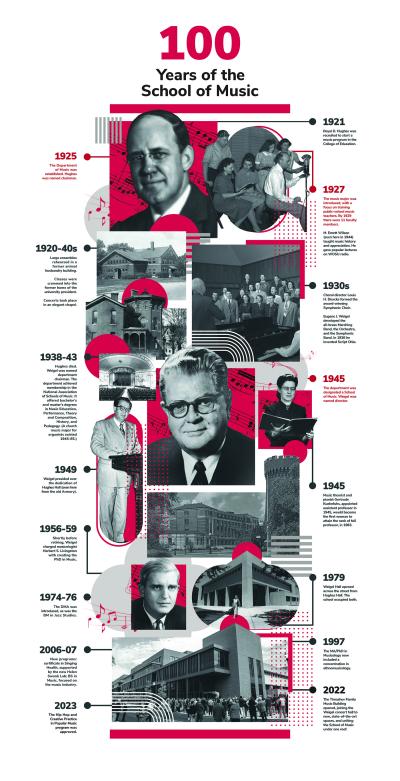Design Students Borami Kang and Emily Holt help Ohio State School of Music Honor 100th Anniversary

This year The Ohio State University School of Music celebrates its 100th anniversary of educating and uplifting the musicians of tomorrow. A reception held on September 8 culminated in the unveiling of the newly installed Legacy Wall in the South Commons of the Timashev Family Music Building. The wall acts as a reminder and celebration of the School of Music’s past for students and visitors alike to appreciate.
The right side of the Legacy Wall features a vertical timeline of significant events in the school’s history, visually dotted with musical motifs and archival photos in Ohio State’s signature scarlet and gray. The leftmost part of the wall focuses the School of Music’s impact throughout the years featuring everything from unique learning spaces, notable alumni and visitors, faculty research, student ensembles and the school’s impact on the greater Columbus area.

Honoring such an extensive history is no small task, so the School of Music looked to the Department of Design to help take on the challenge.
The design of the project was spearheaded by design students Borami Kang and Emily Holt with guidance from department chair Dr Fabienne Munch and Visual Communication Design coordinator Yvette Shen.
With 18 years of graphic design experience under her belt and a BFA from the University of Illinois Urbana-Champaign, MFA candidate Borami Kang joined the project after being approached by Dr Münch. Now an Ohio State alumna and graphic designer for Ohio State Athletics, Emily Holt joined the project upon an offer from Professor Shen as a unique means of completing her senior thesis.
Kang and Holt also worked closely with committee co-chairs Katherine Borst Jones and Lois Rosow who assisted in archival research for the project. This connection between departments was invaluable to the designers as they worked to condense the school’s 100-year history.
“It was a joy working with both of them. We sat down at coffee shops together just to discuss the history. They were telling me stories and (we were) trying to condense the information in order for it to fit on the wall” says Holt, who worked primarily on the timeline portion of the wall.
In fact, one of the biggest challenges for both designers was the condensing of information.
“There were several times where (Jones and Rosow) presented me with a 10 page document of words and I’m like this is good to know but how do we condense this into 72-point font on a large wall because you don’t want it to be overwhelming for the viewer” says Holt.
For Holt, reaching her vision was all about communication, “I spent a lot of time setting up intentional time with them in person because I feel like they communicated better in person”
Kang took her own highly categorized approach to designing past those challenges on the left portion of the wall.
“I went through all the resources that they gave us which was the content in text and then images in pictures. We did a lot of sketches and layout designs before going to the final design. Then I used a grid system to lay out all the text and pictures in squares. I wanted to make sure (the information) is all in the categorized sections” says Kang.
After months of hard work and playing around with different ideas for the wall, seeing the final product printed and displayed was incredibly rewarding for both designers.
“It’s cool when you stare at a digital file for nine months and then you see it printed. I’m proud of the process. We started with an idea of putting eight TV screen son the wall and then we ended up with fully printed vinyl sheets” says Holt.
“I’m mostly proud of how we collaborated with them because we don’t have similar backgrounds and (the School of Music) had a lot of information, but we figured out the visual language instead of just text and images,” says Kang, “We are proud that we could deliver all of the information as a beautiful design piece. We are designers so we’re proud that we could do our part.”
